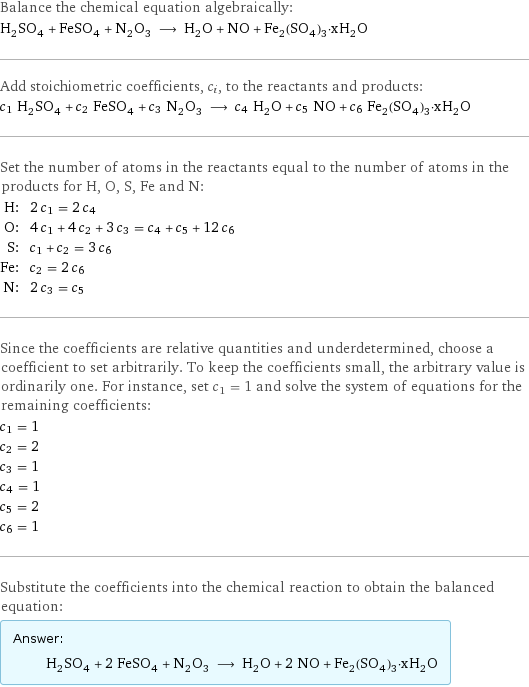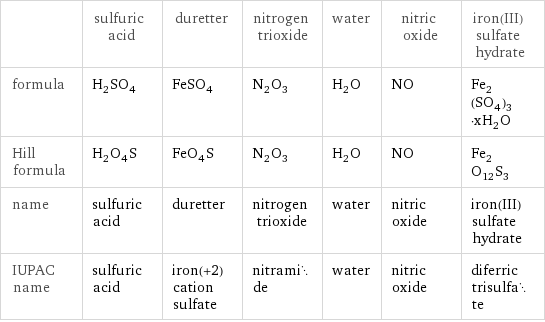Input interpretation

H_2SO_4 sulfuric acid + FeSO_4 duretter + N_2O_3 nitrogen trioxide ⟶ H_2O water + NO nitric oxide + Fe_2(SO_4)_3·xH_2O iron(III) sulfate hydrate
Balanced equation

Balance the chemical equation algebraically: H_2SO_4 + FeSO_4 + N_2O_3 ⟶ H_2O + NO + Fe_2(SO_4)_3·xH_2O Add stoichiometric coefficients, c_i, to the reactants and products: c_1 H_2SO_4 + c_2 FeSO_4 + c_3 N_2O_3 ⟶ c_4 H_2O + c_5 NO + c_6 Fe_2(SO_4)_3·xH_2O Set the number of atoms in the reactants equal to the number of atoms in the products for H, O, S, Fe and N: H: | 2 c_1 = 2 c_4 O: | 4 c_1 + 4 c_2 + 3 c_3 = c_4 + c_5 + 12 c_6 S: | c_1 + c_2 = 3 c_6 Fe: | c_2 = 2 c_6 N: | 2 c_3 = c_5 Since the coefficients are relative quantities and underdetermined, choose a coefficient to set arbitrarily. To keep the coefficients small, the arbitrary value is ordinarily one. For instance, set c_1 = 1 and solve the system of equations for the remaining coefficients: c_1 = 1 c_2 = 2 c_3 = 1 c_4 = 1 c_5 = 2 c_6 = 1 Substitute the coefficients into the chemical reaction to obtain the balanced equation: Answer: | | H_2SO_4 + 2 FeSO_4 + N_2O_3 ⟶ H_2O + 2 NO + Fe_2(SO_4)_3·xH_2O
Structures

+ + ⟶ + +
Names

sulfuric acid + duretter + nitrogen trioxide ⟶ water + nitric oxide + iron(III) sulfate hydrate
Equilibrium constant
![Construct the equilibrium constant, K, expression for: H_2SO_4 + FeSO_4 + N_2O_3 ⟶ H_2O + NO + Fe_2(SO_4)_3·xH_2O Plan: • Balance the chemical equation. • Determine the stoichiometric numbers. • Assemble the activity expression for each chemical species. • Use the activity expressions to build the equilibrium constant expression. Write the balanced chemical equation: H_2SO_4 + 2 FeSO_4 + N_2O_3 ⟶ H_2O + 2 NO + Fe_2(SO_4)_3·xH_2O Assign stoichiometric numbers, ν_i, using the stoichiometric coefficients, c_i, from the balanced chemical equation in the following manner: ν_i = -c_i for reactants and ν_i = c_i for products: chemical species | c_i | ν_i H_2SO_4 | 1 | -1 FeSO_4 | 2 | -2 N_2O_3 | 1 | -1 H_2O | 1 | 1 NO | 2 | 2 Fe_2(SO_4)_3·xH_2O | 1 | 1 Assemble the activity expressions accounting for the state of matter and ν_i: chemical species | c_i | ν_i | activity expression H_2SO_4 | 1 | -1 | ([H2SO4])^(-1) FeSO_4 | 2 | -2 | ([FeSO4])^(-2) N_2O_3 | 1 | -1 | ([N2O3])^(-1) H_2O | 1 | 1 | [H2O] NO | 2 | 2 | ([NO])^2 Fe_2(SO_4)_3·xH_2O | 1 | 1 | [Fe2(SO4)3·xH2O] The equilibrium constant symbol in the concentration basis is: K_c Mulitply the activity expressions to arrive at the K_c expression: Answer: | | K_c = ([H2SO4])^(-1) ([FeSO4])^(-2) ([N2O3])^(-1) [H2O] ([NO])^2 [Fe2(SO4)3·xH2O] = ([H2O] ([NO])^2 [Fe2(SO4)3·xH2O])/([H2SO4] ([FeSO4])^2 [N2O3])](../image_source/d1dfa627305a35c7fc5e2ababdc98753.png)
Construct the equilibrium constant, K, expression for: H_2SO_4 + FeSO_4 + N_2O_3 ⟶ H_2O + NO + Fe_2(SO_4)_3·xH_2O Plan: • Balance the chemical equation. • Determine the stoichiometric numbers. • Assemble the activity expression for each chemical species. • Use the activity expressions to build the equilibrium constant expression. Write the balanced chemical equation: H_2SO_4 + 2 FeSO_4 + N_2O_3 ⟶ H_2O + 2 NO + Fe_2(SO_4)_3·xH_2O Assign stoichiometric numbers, ν_i, using the stoichiometric coefficients, c_i, from the balanced chemical equation in the following manner: ν_i = -c_i for reactants and ν_i = c_i for products: chemical species | c_i | ν_i H_2SO_4 | 1 | -1 FeSO_4 | 2 | -2 N_2O_3 | 1 | -1 H_2O | 1 | 1 NO | 2 | 2 Fe_2(SO_4)_3·xH_2O | 1 | 1 Assemble the activity expressions accounting for the state of matter and ν_i: chemical species | c_i | ν_i | activity expression H_2SO_4 | 1 | -1 | ([H2SO4])^(-1) FeSO_4 | 2 | -2 | ([FeSO4])^(-2) N_2O_3 | 1 | -1 | ([N2O3])^(-1) H_2O | 1 | 1 | [H2O] NO | 2 | 2 | ([NO])^2 Fe_2(SO_4)_3·xH_2O | 1 | 1 | [Fe2(SO4)3·xH2O] The equilibrium constant symbol in the concentration basis is: K_c Mulitply the activity expressions to arrive at the K_c expression: Answer: | | K_c = ([H2SO4])^(-1) ([FeSO4])^(-2) ([N2O3])^(-1) [H2O] ([NO])^2 [Fe2(SO4)3·xH2O] = ([H2O] ([NO])^2 [Fe2(SO4)3·xH2O])/([H2SO4] ([FeSO4])^2 [N2O3])
Rate of reaction
![Construct the rate of reaction expression for: H_2SO_4 + FeSO_4 + N_2O_3 ⟶ H_2O + NO + Fe_2(SO_4)_3·xH_2O Plan: • Balance the chemical equation. • Determine the stoichiometric numbers. • Assemble the rate term for each chemical species. • Write the rate of reaction expression. Write the balanced chemical equation: H_2SO_4 + 2 FeSO_4 + N_2O_3 ⟶ H_2O + 2 NO + Fe_2(SO_4)_3·xH_2O Assign stoichiometric numbers, ν_i, using the stoichiometric coefficients, c_i, from the balanced chemical equation in the following manner: ν_i = -c_i for reactants and ν_i = c_i for products: chemical species | c_i | ν_i H_2SO_4 | 1 | -1 FeSO_4 | 2 | -2 N_2O_3 | 1 | -1 H_2O | 1 | 1 NO | 2 | 2 Fe_2(SO_4)_3·xH_2O | 1 | 1 The rate term for each chemical species, B_i, is 1/ν_i(Δ[B_i])/(Δt) where [B_i] is the amount concentration and t is time: chemical species | c_i | ν_i | rate term H_2SO_4 | 1 | -1 | -(Δ[H2SO4])/(Δt) FeSO_4 | 2 | -2 | -1/2 (Δ[FeSO4])/(Δt) N_2O_3 | 1 | -1 | -(Δ[N2O3])/(Δt) H_2O | 1 | 1 | (Δ[H2O])/(Δt) NO | 2 | 2 | 1/2 (Δ[NO])/(Δt) Fe_2(SO_4)_3·xH_2O | 1 | 1 | (Δ[Fe2(SO4)3·xH2O])/(Δt) (for infinitesimal rate of change, replace Δ with d) Set the rate terms equal to each other to arrive at the rate expression: Answer: | | rate = -(Δ[H2SO4])/(Δt) = -1/2 (Δ[FeSO4])/(Δt) = -(Δ[N2O3])/(Δt) = (Δ[H2O])/(Δt) = 1/2 (Δ[NO])/(Δt) = (Δ[Fe2(SO4)3·xH2O])/(Δt) (assuming constant volume and no accumulation of intermediates or side products)](../image_source/6d41bf08cdcb1f8ac3c465d90dfbd6ca.png)
Construct the rate of reaction expression for: H_2SO_4 + FeSO_4 + N_2O_3 ⟶ H_2O + NO + Fe_2(SO_4)_3·xH_2O Plan: • Balance the chemical equation. • Determine the stoichiometric numbers. • Assemble the rate term for each chemical species. • Write the rate of reaction expression. Write the balanced chemical equation: H_2SO_4 + 2 FeSO_4 + N_2O_3 ⟶ H_2O + 2 NO + Fe_2(SO_4)_3·xH_2O Assign stoichiometric numbers, ν_i, using the stoichiometric coefficients, c_i, from the balanced chemical equation in the following manner: ν_i = -c_i for reactants and ν_i = c_i for products: chemical species | c_i | ν_i H_2SO_4 | 1 | -1 FeSO_4 | 2 | -2 N_2O_3 | 1 | -1 H_2O | 1 | 1 NO | 2 | 2 Fe_2(SO_4)_3·xH_2O | 1 | 1 The rate term for each chemical species, B_i, is 1/ν_i(Δ[B_i])/(Δt) where [B_i] is the amount concentration and t is time: chemical species | c_i | ν_i | rate term H_2SO_4 | 1 | -1 | -(Δ[H2SO4])/(Δt) FeSO_4 | 2 | -2 | -1/2 (Δ[FeSO4])/(Δt) N_2O_3 | 1 | -1 | -(Δ[N2O3])/(Δt) H_2O | 1 | 1 | (Δ[H2O])/(Δt) NO | 2 | 2 | 1/2 (Δ[NO])/(Δt) Fe_2(SO_4)_3·xH_2O | 1 | 1 | (Δ[Fe2(SO4)3·xH2O])/(Δt) (for infinitesimal rate of change, replace Δ with d) Set the rate terms equal to each other to arrive at the rate expression: Answer: | | rate = -(Δ[H2SO4])/(Δt) = -1/2 (Δ[FeSO4])/(Δt) = -(Δ[N2O3])/(Δt) = (Δ[H2O])/(Δt) = 1/2 (Δ[NO])/(Δt) = (Δ[Fe2(SO4)3·xH2O])/(Δt) (assuming constant volume and no accumulation of intermediates or side products)
Chemical names and formulas

| sulfuric acid | duretter | nitrogen trioxide | water | nitric oxide | iron(III) sulfate hydrate formula | H_2SO_4 | FeSO_4 | N_2O_3 | H_2O | NO | Fe_2(SO_4)_3·xH_2O Hill formula | H_2O_4S | FeO_4S | N_2O_3 | H_2O | NO | Fe_2O_12S_3 name | sulfuric acid | duretter | nitrogen trioxide | water | nitric oxide | iron(III) sulfate hydrate IUPAC name | sulfuric acid | iron(+2) cation sulfate | nitramide | water | nitric oxide | diferric trisulfate